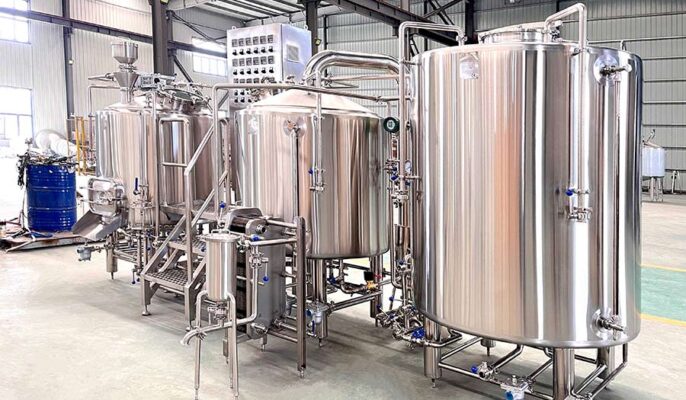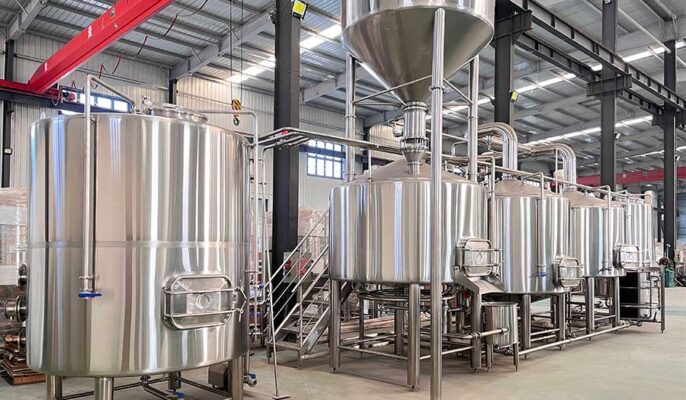Ať už se jedná o domácí nebo komerční vaření piva, během procesu vaření piva se mohou vyskytnout velké i malé problémy, které mohou ovlivnit kvalitu piva. V tomto článku se dozvíte jednoduchá preventivní opatření ke zlepšení kvality vašeho piva.
Hygienické problémy
Jedním z nejčastějších problémů při výrobě piva, který se dá nejsnáze odstranit, je špatná sanitace pivovarského zařízení. Kontaminanty mohou způsobit vážné poškození piva, což vede ke zkaženému pivu a potenciálně zkaženým várkám.
Prvním krokem při vaření piva je vyčištění pivovarského zařízení. Vaření piva je velmi složitý proces a udržování pivovarského zařízení v čistotě nejen udržuje celek, ale také pomáhá chránit kvalitu a chuť piva.
Na začátku důkladně vydezinfikujte veškeré pivovarské vybavení, včetně fermentorů, vzdušných zámků a pivovarského náčiní. Používejte dezinfekční prostředky specifické pro pivovarnictví; čistota je klíčem k tomu, aby škodlivé mikroorganismy neohrožovaly kvalitu piva.
Poznámka: Mezi čištěním a dezinfekcí je důležitý rozdíl. Správným čištěním pivovarského zařízení se odstraní nečistoty, prach a vodní kámen, stejně jako tuky, bílkoviny a různé lepivé látky, které mohou zničit chuť piva. Sanitace nic z výše uvedeného neovlivňuje, ale ničí škodlivé bakterie způsobem, který samotné čištění nedokáže.

Používání nekvalitní vody
Voda z kohoutku ve vašem okolí může být chutná, ale když ji přidáte do piva, může mu to uškodit. Nefiltrovaná, chlorovaná voda může pivu dodat kovovou a plastovou příchuť. Hodnota pH a rozložení iontů ve vodě se v jednotlivých regionech liší, což může změnit výslednou hustotu, pH a chuť vašeho piva.
S rozvojem řemeslného piva po celém světě se mnoho těchto pivních stylů vyrábí podle druhu vody, která je v daném regionu k dispozici.
Místní voda z kohoutku nemusí mít minerální látky nebo vyvážené pH, které jsou potřebné pro výrobu vámi používaného receptu. K úpravě kvality místní vody můžete použít zařízení na úpravu vody, které zajistí chuť vašeho piva. Samozřejmě můžete také vyladit svůj recept, abyste zajistili vyváženost minerálů ve vašem pivu.
Pomalé kvašení piva
Jedná se o jeden z nejčastějších problémů. Po přenesení mladiny do kvasného kádě může kvašení trvat až 6-8 hodin. Nepropadejte panice, pokud se během této doby neobjeví žádné známky kvašení, je to normální. Kvašení je kritická fáze, kdy kvasinky přeměňují cukr na alkohol a produkují oxid uhličitý, který dokončí proces kvašení v kvasném kádi. Někdy se může proces zastavit nebo trvat déle, než se očekávalo, a to hlavně kvůli nedostatečnému množství kvasinek, síle kvasinek nebo nesprávné teplotě.
Důvody pomalého nebo žádného kvašení:
- Nedostatečné množství kvasinek. Nedostatečné množství kvasinek může způsobit pomalé kvašení, problém jednoduše vyřešíte opětovným vložením správného množství kvasinek do fermentoru.
- Teplota mladiny je příliš vysoká. Všechny kvasinky potřebují ke kvašení správný rozsah teplot. Pokud je teplota příliš vysoká, kvasinky mohou uhynout. Teprve po ochlazení mladiny by se měla přenést zpět do kvasného kádě ke kvašení.
- Teplota mladiny je příliš nízká. Při příliš nízké teplotě mohou kvasinky přestat pracovat, což vede k pomalému kvašení.
- Sanitizér ve fermentoru není třeba proplachovat. Zbytky dezinfekčního prostředku mohou stále ničit kvasinky a fermentor je třeba po dezinfekci vypláchnout, aby se zbytky dezinfekčního prostředku odstranily.
Nesrovnalosti v teplotě
Udržování konstantní teploty v průběhu celého procesu vaření je zásadní pro dosažení požadované chuti a vůně a zajištění správného kvašení. Kolísání teploty může způsobit stres kvasinek, který může změnit chuť a vést ke komplikacím při interakci mladiny s kvasinkami.
Pořiďte si spolehlivý teploměr a pečlivě sledujte teplotu v každé fázi, včetně rmutování, vaření a kvašení.
Abyste se vyhnuli problémům s vařením nekvalitního piva, měla by se správná teplota pohybovat mezi 45 a 72 stupni Fahrenheita a měla by být vyladěna podle fáze procesu. Jedná se o zásadní krok, protože kvašení trvá několik týdnů a špatná teplota vás z hlediska postupu vrátí téměř na začátek.
Řídká chuť a vůně
Mírné chutě a vůně mohou snížit kvalitu piva, zejména po čase a úsilí, které bylo do vaření piva investováno. K těmto nežádoucím vlastnostem může přispět řada faktorů, například špatný výběr kvasnic, nadměrné vystavení kyslíku, bakteriální kontaminace nebo špatná kontrola teploty kvašení.
Chuť a vůně piva pochází z různých ingrediencí, jako jsou zrna a chmel, a také z doby kvašení v kvasné nádobě. Dodržování receptur, pozornost věnovaná detailům, správné hospodaření s přísadami a včasné procesy zajistí přesný a konzistentní produkt. Porozumění vaření piva vám umožní vyvážit a dosáhnout správné chuti jednoduchou úpravou množství a kvality chmele, zrn a kvasnic.
Znalost způsobu řešení problémů při vaření piva vám pomůže identifikovat konkrétní nepříjemné chutě nebo vůně a porovnat je s běžnými problémy při vaření piva. To vám pomůže zúžit možné příčiny a přijmout vhodná nápravná opatření, ať už jde o úpravu podmínek kvašení, revizi hygienických postupů nebo zkoumání různých kmenů kvasinek.
Problémy s karbonizací
Dalším důležitým aspektem piva je sycení a problémy se sycením mohou vést k nadměrnému nebo nedostatečnému sycení piva. Příliš saturované pivo při nalévání pění, zatímco nedostatečně saturované pivo je ploché a bez chuti. Nejlepším způsobem, jak předcházet problémům se sycením, je sledovat úroveň sycení a podle potřeby ji upravovat.
Abyste těmto problémům předešli, dbejte při přidávání cukru na přesné měření a zvažte použití kalkulačky sycení pro výpočet přesného množství. Při sycení je klíčová trpělivost, protože může trvat i několik týdnů, než se pivo plně nasytí oxidem uhličitým; před úpravami si také nechte dostatek času na dokončení procesu.

Zdravotní stav kvasinek a míra očkování
Pro úspěšné kvašení je rozhodující, aby bylo inokulum kvasinek zdravé a ve správné míře. Správná příprava kvasinek (např. použití zákysu pro tekuté kvasinky nebo rehydratace suchých kvasinek) je velkým přínosem pro dosažení silného kvašení.
Nezapomeňte také přidat správné množství droždí. Snížíte tak riziko stagnace nebo neúplného kvašení a v konečném důsledku uvaříte pivo lepší chuti.
Závěrem lze říci, že zaměření na hygienu, údržbu zařízení a zdraví kvasinek může pomoci předcházet běžným problémům v pivovarnictví. fermentory. Provedením těchto preventivních opatření budete moci trvale vyrábět pivo skvělé chuti.
Další často kladené otázky
Proč ve zkvašeném pivu plave slizká, křupavá nebo podivně vypadající hmota?
Kvašení může být pro amatéra nebo začínajícího sládka velmi nepříjemnou událostí se spoustou podivných kalů a kondenzačních chuchvalců. V 99,9% případů je to zcela normální a je to jen výsledek kvašení. Zkuste si s tím nedělat starosti a pokračujte jako obvykle.
Je moje pivo infikované?
Pivo během kvašení hodně plave, což může být důvodem k obavám, zejména pokud se to při poslední várce nevyskytovalo a první, co byste měli udělat, je usoudit, že je pivo kontaminované. To je zcela mylné, v 99% případech se jedná pouze o přirozeně se vyskytující nečistotu z běžného procesu kvašení. Nechte pivo normálně prokvasit a pak pokračujte jako obvykle a obvykle se není čeho obávat.
Musím dát pivo do sekundárního kvašení?
Ve většině případů ne, pivo můžete nechat ve stejné kvasné nádobě a stáčet do lahví nebo sudů bez sekundárního kvašení. Pokud bude pivo ležet ve stejné nádobě 3 až 5 týdnů, nedojde k žádným nepříjemným příchutím nebo problémům, pokud bude ležet déle, zvažte jeho přelití.




